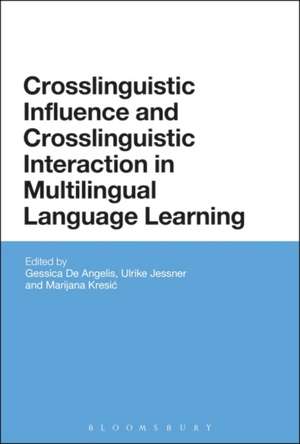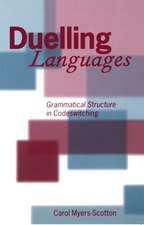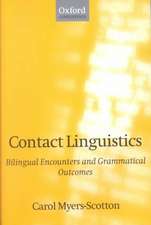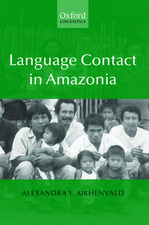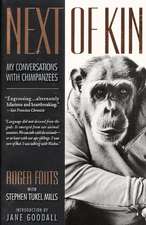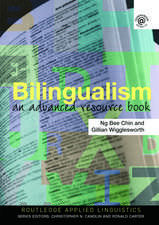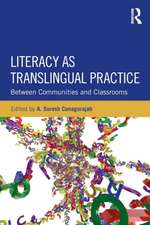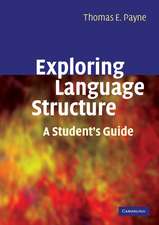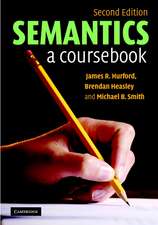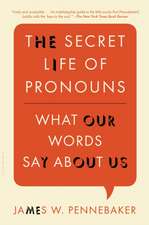Crosslinguistic Influence and Crosslinguistic Interaction in Multilingual Language Learning
Editat de Gessica De Angelis, Ulrike Jessner, Marijana Kresicen Limba Engleză Paperback – 17 mai 2017
| Toate formatele și edițiile | Preț | Express |
|---|---|---|
| Paperback (1) | 257.97 lei 6-8 săpt. | |
| Bloomsbury Publishing – 17 mai 2017 | 257.97 lei 6-8 săpt. | |
| Hardback (1) | 774.62 lei 6-8 săpt. | |
| Bloomsbury Publishing – 21 oct 2015 | 774.62 lei 6-8 săpt. |
Preț: 257.97 lei
Preț vechi: 331.43 lei
-22% Nou
Puncte Express: 387
Preț estimativ în valută:
49.36€ • 51.54$ • 40.76£
49.36€ • 51.54$ • 40.76£
Carte tipărită la comandă
Livrare economică 15-29 aprilie
Preluare comenzi: 021 569.72.76
Specificații
ISBN-13: 9781350036482
ISBN-10: 135003648X
Pagini: 272
Dimensiuni: 156 x 234 x 20 mm
Greutate: 0.39 kg
Ediția:NIPPOD
Editura: Bloomsbury Publishing
Colecția Bloomsbury Academic
Locul publicării:London, United Kingdom
ISBN-10: 135003648X
Pagini: 272
Dimensiuni: 156 x 234 x 20 mm
Greutate: 0.39 kg
Ediția:NIPPOD
Editura: Bloomsbury Publishing
Colecția Bloomsbury Academic
Locul publicării:London, United Kingdom
Caracteristici
Looks specifically at cross-linguistic interaction, something that research in multilingualism hasn't always taken a close look at.
Notă biografică
Gessica De Angelis is Assistant Professor at Trinity College Dublin, Ireland. Urlike Jessner is Associate Professor at University of Innsbruck, Austria.Marijana Kresic is Associate Professor at University of Zadar, Croatia.
Cuprins
1. IntroductionGessica De Angelis (Trinity College Dublin, Ireland); Ulrike Jessner (University of Innsbruck, Austria); Marijana Kresic (University of Zadar, Croatia)2. Perceptual Training of Novel Speech Contrasts in L3 Acquisition: The Effect of Multilingual BenefitDivya Verma Gogoi, James D. Harnsberger and Caroline Wiltshire (University of Florida, USA) 3. The Lexicon-Syntax Interfacein 3L1 acquisition: An Experimental Investigation of the Unaccusative/Unergative DistinctionMegan Devlin, Raffaella Folli and Christina Sevdali (University of Ulster, Ireland)4. Can a Background Language Alter the Path of Acquisition of Verb Placement in a Multilingual Context? Evidence from a Longitudinal StudyLaura Sánchez (University of Barcelona, Spain)5. Item-related determinants of cognate guessing in multilingualsJan Vanhove and Raphael Berthele (University of Fribourg, Switzerland)6. Developing Cognitive Strategies through Pluralistic approachesRebecca Dahm (Université de Limoges, France)7. "If you know Amharic you can read this": Emergent literacy in multilingual pre-reading children Anat Stavans (Beit Berl College and Research Institute for Innovation in Education at Hebrew University in Jerusalem, Israel)8. Does German help speakers of Dutch to understand written and spoken Danish words? - The role of second language knowledge in decoding an unknown but related languageFemke Swarte, Anja Schüppert and Charlotte Gooskens (University of Groningen, The Netherlands)9. Is A2 in German better than B2 in French when reading Danish? The role of prior language knowledge when faced with an unknown languageKarolina Mieszkowska and Agnieszka Otwinowska (University of Warsaw, Poland)10. Do learners transfer from the language they perceive as most closely related to the L3? The role of psychotypology for lexical and grammatical cross-linguistic influence in French L3Christina Lindqvist (Uppsala University, Sweden)11. Epilogue De Angelis, Jessner, KresicBibliographyIndex
Recenzii
The strength is that the information of the book applies not only to teaching and learning English as is traditionally the case, but to other languages which are taught in many countries in addition to English. This makes the volume very important practically. Dealing with different languages, including languages as different as Dutch, Spanish, Scottish and Italian, rather than only English, it is of value to many places in the world. The collection deepens the topic, focusing on how speakers perceive the closeness between languages.
This volume, while remaining all the time true to its theme of crosslinguistic influence and interaction in multilingual learning, offers a quite breathtaking array of engaging perspectives on this theme. The fascinating range of theoretical and methodological treatments and the variety of results and interpretations it presents demonstrate yet again the rich diversity of multilingualism studies, and the way in which a topic like crosslinguistic impact, which was once regarded as straightforward (!), takes on an infinity of complexities in a multilingual context.
This volume, while remaining all the time true to its theme of crosslinguistic influence and interaction in multilingual learning, offers a quite breathtaking array of engaging perspectives on this theme. The fascinating range of theoretical and methodological treatments and the variety of results and interpretations it presents demonstrate yet again the rich diversity of multilingualism studies, and the way in which a topic like crosslinguistic impact, which was once regarded as straightforward (!), takes on an infinity of complexities in a multilingual context.
